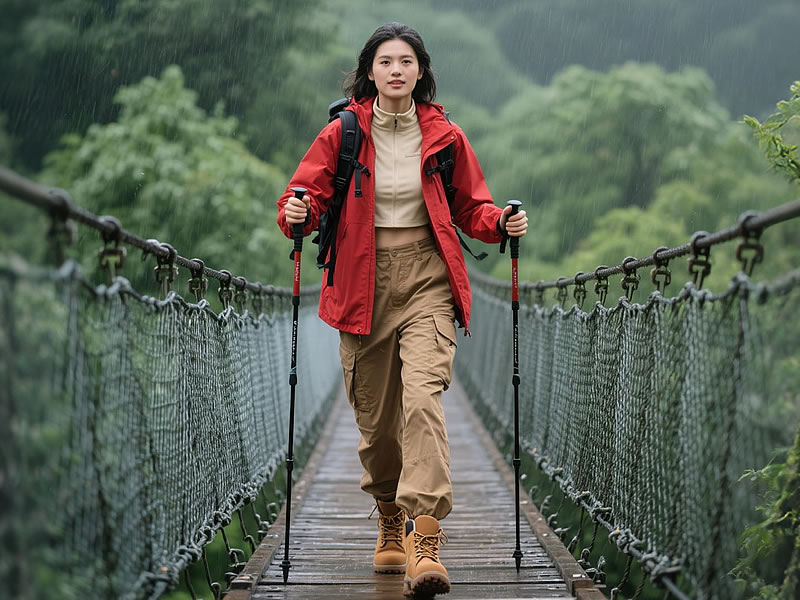Essential gear for hiking in rainy climates
Hiking in relentless rain demands more than a basic rain jacket—it requires a system to combat hypothermia, slippery trails, and gear failure. Whether you're trekking Pacific Northwest forests, Scottish highlands, or tropical monsoons, this evidence-based guide covers the non-negotiable gear and strategies for true weather protection.

The Core Layering System: Beyond "Waterproof"
1. Base Layer: Moisture Management
- Material: Merino wool (170-200gsm) or synthetic (polyester/nylon)
- Avoid cotton—it loses insulation when wet and dries slowly.
- Fit: Snug but not restrictive for optimal warmth transfer.
2. Mid Layer: Reliable Insulation
- Synthetic Puffy (e.g., Primaloft Gold): Retains heat when damp (unlike down).
- Fleece Jacket: Breathable under rain shells (Patagonia R1 TechFace recommended).
3. Outer Shell: The Rain Defense
| Feature | Why It Matters |
|---|---|
| 3-Layer Gore-Tex | Gold standard for waterproof/breathable balance |
| Pit Zips | Critical for venting heat on climbs |
| Storm Hood | Fits over helmets, adjusts in wind |
| Taped Seams | Prevents needle-hole leaks |
Pro Tip: Treat jackets annually with DWR spray to revive water beading.
Lower Body Protection: Don’t Forget Legs!
- Rain Pants: Full side zips (for quick on/off over boots) + articulated knees.Top Pick: Outdoor Research Foray II (ultralight, 40D ripstop)
- Gaiters: Prevent water/debris from entering boots (e.g., Outdoor Research Crocodiles).
Footwear: The Wet-Terrain Trio
- Waterproof Boots:Look for Gore-Tex lining + Vibram Megagrip soles (e.g., Salomon Quest 4 GTX).
- Socks:Merino wool blend (e.g., Darn Tough Mountaineering)—resists blisters when damp.
- Prevention:Apply hydrophobic wax (e.g., Nikwax) to leather boots pre-hike.
Pack & Gear Protection: Keep Essentials Dry
- Rain Cover: Sized 10L larger than your pack (e.g., Osprey UltraLight).
- Internal Dry Bags:Use multiple sizes (electronics in 3L, clothes in 8L).Pro Tip: Put phone in a ziplock inside a dry bag—double security!
Critical Safety Extras for Hypothermia Prevention
- Emergency Bivvy: SOL Escape Lite (reflects 90% body heat).
- Fire Kit: Stormproof matches + ferro rod in waterproof case.
- Navigation: Waterproof map case or phone in AquaQuest waterproof pouch.
- Lighting: Headlamp with lithium batteries (perform better in cold/wet).
Region-Specific Adjustments
Tropical Rainforests
- Bug Defense: Permethrin-treated clothing + head net.
- Quick-Dry Clothing: Convertible pants to shorts.
Cold/Temperate Rain
- Gloves: Showa Temres 282 (waterproof, <$30).
- Neck Gaiter: Buff Polar (fleece-lined).
Pro Techniques for Rainy Hiking
- Venting Rhythm: Open pit zips before sweating heavily.
- River Crossings: Wear trail runners (not boots) + use trekking poles for stability.
- Camp Setup: Pitch tent on slightly elevated ground—avoid natural drainage paths.
"Hypothermia risk spikes at 50°F (10°C) when wet—far warmer than most hikers realize."— Wilderness Medical Society Guidelines
Budget vs. Premium Picks
| Gear | Budget Choice | Premium Upgrade |
|---|---|---|
| Rain Jacket | Marmot PreCip Eco | Arc'teryx Beta LT |
| Rain Pants | REI Co-op Rainier | Norrøna Falketind |
| Waterproof Pack | Sea to Summit Ultra-Sil | Hyperlite Mountain Gear |
Final Wisdom:
Rain hiking reveals gear flaws mercilessly. Test everything locally before multi-day trips. Prioritize ventilation over maximum waterproofing—sweat-soaked gear is as dangerous as rain. Embrace the drizzle; with the right kit, you’ll discover trails transformed by rain’s quiet magic.






